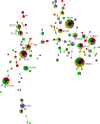MLST-based genetic relatedness of Campylobacter jejuni isolated from chickens and humans in Poland
- PMID: 31978059
- PMCID: PMC6980552
- DOI: 10.1371/journal.pone.0226238
MLST-based genetic relatedness of Campylobacter jejuni isolated from chickens and humans in Poland
Abstract
Campylobacter jejuni infection is one of the most frequently reported foodborne bacterial diseases worldwide. The main transmission route of these microorganisms to humans is consumption of contaminated food, especially of chicken origin. The aim of this study was to analyze the genetic relatedness of C. jejuni from chicken sources (feces, carcasses, and meat) and from humans with diarrhea as well as to subtype the isolates to gain better insight into their population structure present in Poland. C. jejuni were genotyped using multilocus sequence typing (MLST) and sequence types (STs) were assigned in the MLST database. Among 602 isolates tested, a total of 121 different STs, including 70 (57.9%) unique to the isolates' origin, and 32 STs that were not present in the MLST database were identified. The most prevalent STs were ST464 and ST257, with 58 (9.6%) and 52 (8.6%) C. jejuni isolates, respectively. Isolates with some STs (464, 6411, 257, 50) were shown to be common in chickens, whereas others (e.g. ST21 and ST572) were more often identified among human C. jejuni. It was shown that of 47 human sequence types, 26 STs (106 isolates), 23 STs (102 isolates), and 29 STs (100 isolates) were also identified in chicken feces, meat, and carcasses, respectively. These results, together with the high and similar proportional similarity indexes (PSI) calculated for C. jejuni isolated from patients and chickens, may suggest that human campylobacteriosis was associated with contaminated chicken meat or meat products or other kinds of food cross-contaminated with campylobacters of chicken origin. The frequency of various sequence types identified in the present study generally reflects of the prevalence of STs in other countries which may suggest that C. jejuni with some STs have a global distribution, while other genotypes may be more restricted to certain countries.
Conflict of interest statement
The authors have declared that no competing interests exist.
Figures

Similar articles
-
Multilocus Sequence Typing (MLST) of Campylobacter jejuni Isolated From Broiler Meat in Egypt.Pak J Biol Sci. 2019 Jan;22(12):574-579. doi: 10.3923/pjbs.2019.574.579. Pak J Biol Sci. 2019. PMID: 31930855
-
Epidemiological relationships of Campylobacter jejuni strains isolated from humans and chickens in South Korea.J Microbiol. 2017 Jan;55(1):13-20. doi: 10.1007/s12275-017-6308-8. Epub 2016 Dec 30. J Microbiol. 2017. PMID: 28035601
-
MLST genotypes of Campylobacter jejuni isolated from broiler products, dairy cattle and human campylobacteriosis cases in Lithuania.BMC Infect Dis. 2017 Jun 15;17(1):430. doi: 10.1186/s12879-017-2535-1. BMC Infect Dis. 2017. PMID: 28619013 Free PMC article.
-
Prevalence and antimicrobial resistance of Campylobacter jejuni and Campylobacter coli over time in Thailand under a One Health approach: A systematic review and meta-analysis.One Health. 2025 Jan 10;20:100965. doi: 10.1016/j.onehlt.2025.100965. eCollection 2025 Jun. One Health. 2025. PMID: 39898318 Free PMC article. Review.
-
A systematic review of source attribution of human campylobacteriosis using multilocus sequence typing.Euro Surveill. 2019 Oct;24(43):1800696. doi: 10.2807/1560-7917.ES.2019.24.43.1800696. Euro Surveill. 2019. PMID: 31662159 Free PMC article.
Cited by
-
Comparative genomics of ESBL-producing Escherichia coli (ESBL-Ec) reveals a similar distribution of the 10 most prevalent ESBL-Ec clones and ESBL genes among human community faecal and extra-intestinal infection isolates in the Netherlands (2014-17).J Antimicrob Chemother. 2021 Mar 12;76(4):901-908. doi: 10.1093/jac/dkaa534. J Antimicrob Chemother. 2021. PMID: 33428729 Free PMC article.
-
Genomic diversity, virulence and source of Campylobacter jejuni contamination in Irish poultry slaughterhouses by whole genome sequencing.J Appl Microbiol. 2022 Nov;133(5):3150-3160. doi: 10.1111/jam.15753. Epub 2022 Aug 22. J Appl Microbiol. 2022. PMID: 35993276 Free PMC article.
-
High prevalence of Campylobacter jejuni CC21 and CC257 clonal complexes in children with gastroenteritis in Tehran, Iran.BMC Infect Dis. 2021 Jan 23;21(1):108. doi: 10.1186/s12879-021-05778-5. BMC Infect Dis. 2021. PMID: 33485317 Free PMC article.
-
Five centuries of genome evolution and multi-host adaptation of Campylobacter jejuni in Brazil.Microb Genom. 2024 Jul;10(7):001274. doi: 10.1099/mgen.0.001274. Microb Genom. 2024. PMID: 39028633 Free PMC article.
-
Antimicrobial Resistance Profiles, Virulence Genes, and Genetic Diversity of Thermophilic Campylobacter Species Isolated From a Layer Poultry Farm in Korea.Front Microbiol. 2021 Mar 29;12:622275. doi: 10.3389/fmicb.2021.622275. eCollection 2021. Front Microbiol. 2021. PMID: 33859624 Free PMC article.
References
Publication types
MeSH terms
LinkOut - more resources
Full Text Sources
Medical

